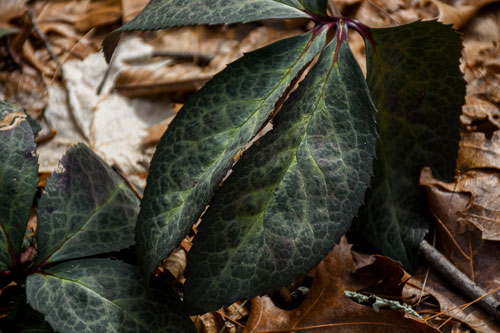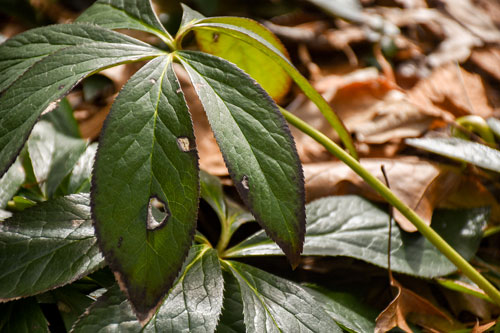By Hunter Blanchard, Horticulturist, New England Botanic Garden
March 2024
As I walk around the Shade Garden on a recent brisk yet warm day, I think about what preparation I need to do as spring begins to unfurl. My favorite part of completing spring garden tasks is discovering inspiration for the upcoming season. I imagine what the spaces will look like in spring, thinking of the past year, and develop a plan for what I’d like to see.
There are a few simple objectives I always have in the spring. Usually, work begins with stick pick-up. Through the winter, heavy snow and strong wind knocks around the forest canopy above the Shade Garden. Large branches and small twigs alike twist, snap, and fall to the forest floor decorating the garden beds. Stick pick-up clears the view of the ground so we can more easily spot our spring ephemerals poking through. These signs of spring are ones we so eagerly anticipate! We also focus on stick pick-up this time of year as it is the least invasive form of spring cleanup —it doesn’t disturb the leaf litter in such an intense way as to disrupt invertebrate diapause, their over wintering state. Our leftover leaf litter becomes a safe haven for the iconic invertebrates we love to see on spring and summer days—bees, butterflies, and lightning bugs, to name a few.
As I look around the garden, I notice the crooked flower buds of winter rose, or hellebores, poking out of the leaf litter. Not only do we leave the leaves on our woodland garden beds, but we do not perform fall cutbacks for every single perennial, especially the leaves of hellebore. These leaves are considered to be evergreen, keeping the integrity of their deep glossy green through winter adding interest, or “winterest,” to the Shade Garden. Selections from the Frost Kiss series such as Helleborus ‘EPB 29’ (Dorothy’s Dawn) and H. ‘ABCRD01’ (Penny’s Pink), which can be found in the Shade Garden, offer additional interest with leaves marbled with silver markings. As winter progresses, hellebore leaves take on a purple blush, a beautiful sign of winter burn which now prompts me to remove them to make way for the flowers and new fresh leaves that emerge shortly after. This year, as the flowers have already started to emerge, I wonder if I’m late to the game? In the past, I’ve tried to cut back the leaves before flowers emerge to lessen the chance of accidentally cutting back the flowers. With a warming climate this has become trickier each year as it depends on the daily temperatures and lack of snow. Cutting back the leaves becomes a delicate dance as I snip leaves missing the flower stalks.
Not long after our hellebores reach peak another Shade Garden favorite of mine begins to emerge, epimedium, or fairy wings. These charismatic garden plants come in many shapes and colors and also carry their glossy evergreen leaves through the winter, some holding on as strong as the hellebore while others die back completely. Like hellebore, epimedium must also be cut back before its spring blooms arise. Their spring flowers subtly sneak out of the leaf litter on delicate pedicels, or small stalks, that would be indistinguishable from last year’s, which is why it is important to cut these plants back early. Generally deer resistant, (though deer have different tastes in different areas), epimedium leaves may still be browsed as winter forage. This leaves behind an army of erect petioles that also need to be cut back to clear the stage for the flowers.
Because it’s home to such a unique plant collection, the Shade Garden often requires a few other miscellaneous tasks to get it ready for spring. This year, this includes cutbacks of evergreen autumn fern, or Dryopteris erythrosora ‘Brilliance’. Like the other perennials, I left the foliage for ”winterest,” so that something beautifully green remained in the garden, but now I’ll cut back old fronds so delicate spring ephemerals have an easier time pushing up through the leaf litter. Once those ephemerals begin to fade, the new fronds of the autumn fern will unfurl to hide them—this seamless aspect of the Shade Garden’s plant combinations is one of its best features.
By the time I’ve cut back the ferns, I hunt around for leftover perennial stems that still have enough integrity to remain standing and cut them back, so the garden is uniform. Had any of the perennial stems been hollow like that of rose mallow, I would have cut them back to 2-3 feet from the ground to give them a polished feel. This also creates excellent habitat for native stem nesting bees.
Lastly, I think about how beauty is in the eye of the beholder, as I may move around the fallen blades of Japanese forest grass (Hakonechloa macra). Left behind for their movement and the sound they make in the wind, ghostly flattened clumps of this grass remain. I may remove or spread the fallen foliage around if I don’t leave it all together. Even in this state, the grass has a presence that mirrors what it added to the garden during the growing season.
Once all is set, I’m free to watch for the next signs of spring specific to our Shade Garden. I walk around and wonder what guests who visit this garden think as they wander around? Is this their Shade Garden? Or do they have a similar space at home that they care for? Will our space and our practices provide inspiration for them? I hope so.
About the Author
Hunter Blanchard is a horticulturist at New England Botanic Garden at Tower Hill in Boylston, MA. He has been with the organization since 2018, serving in roles that allow him to share his passion for making plants accessible to people and for nurturing growing things. Today, Hunter leads a three-person team responsible for roughly 10 acres of naturalistic garden spaces that foster plant biodiversity and support pollinator populations through a focus on North American native plant species. He enjoys interpreting these garden spaces for visitors through tours and talks, hoping that these learning opportunities inspire people to engage more with plants at home or in other areas of their lives. A community builder, Hunter serves on the board of directors for F.E.R.N., a nonprofit that supports conservation by promoting synergy between individuals, communities, and organizations, and on the Conference Planning and Education Committees for the Ecological Landscape Alliance. Hunter holds an A.S. in sustainable horticulture from the Stockbridge School of Agriculture and a B.S. in plant soil science from Umass Amherst. In his free time, Hunter enjoys cooking, caring for an ever-expanding collection of houseplants, and looking after a home aquarium that houses fish, shrimp, and several aquatic plants.



